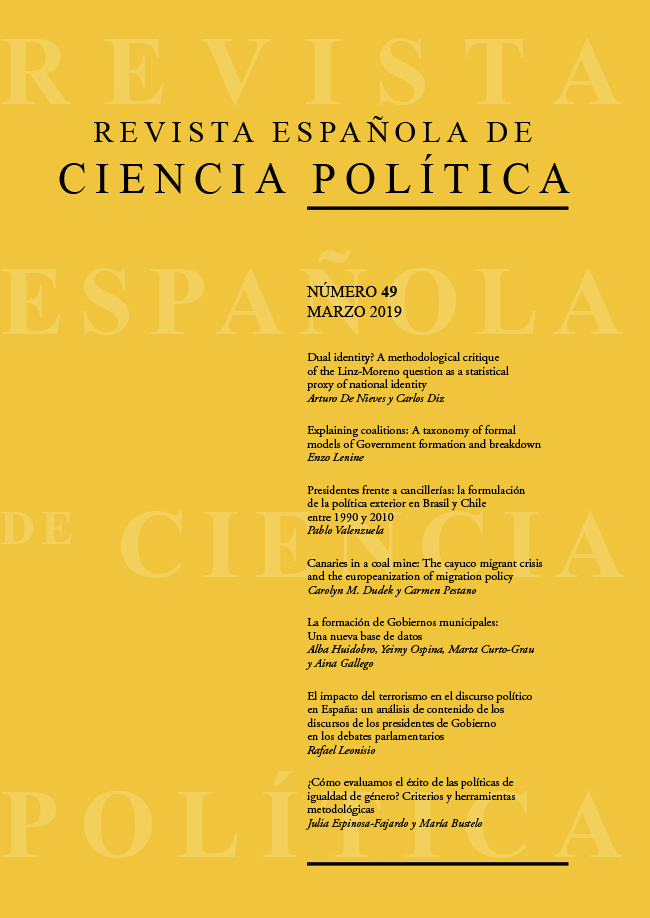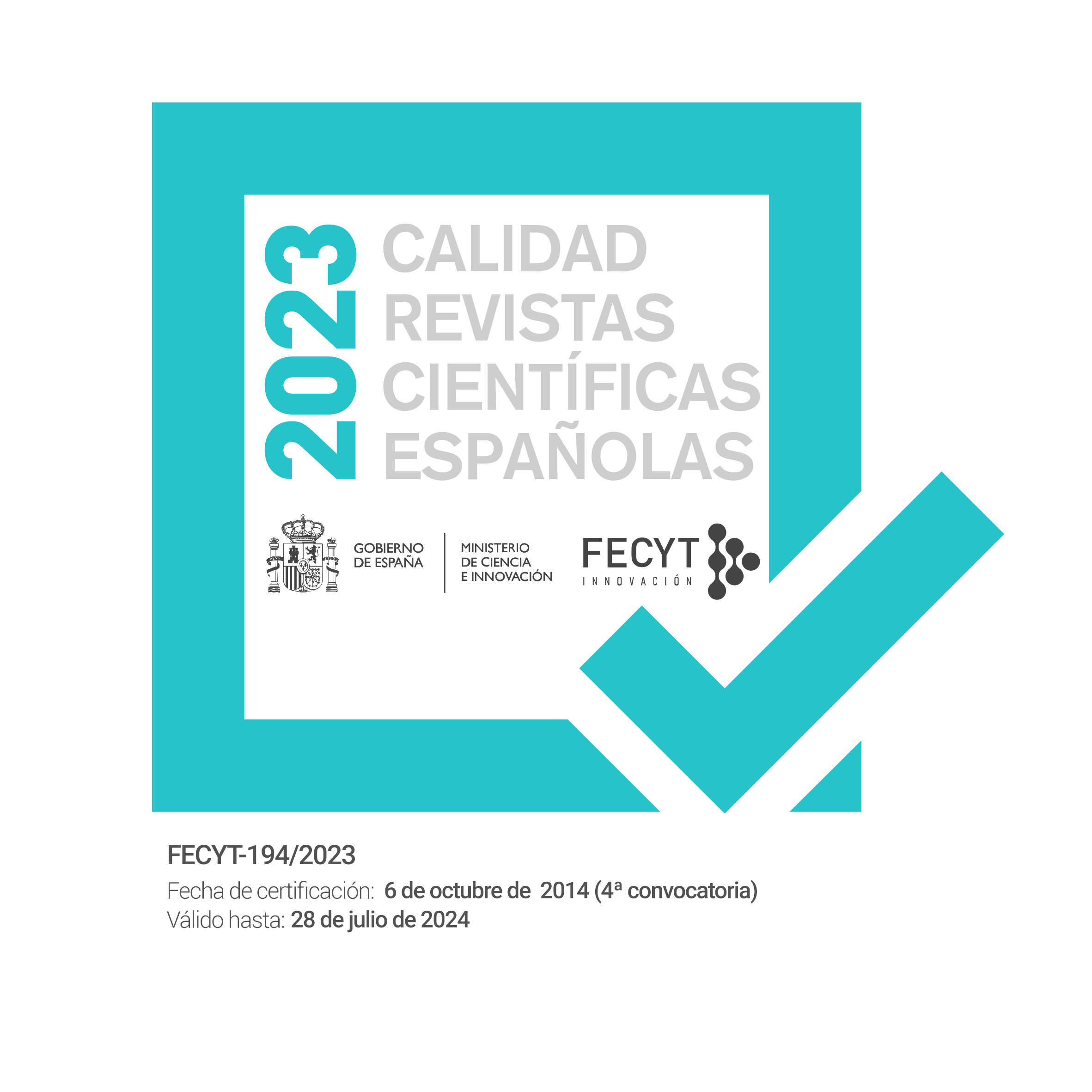Explaining coalitions: A taxonomy of formal models of government formation and breakdown
DOI:
https://doi.org/10.21308/recp.49.02Keywords:
Coalition models, taxonomy of formal models, Government formation, Government breakdown.Abstract
CCoalition theory is one of the fields that has extensively benefited from formal modelling in political science. Since the publication of William Riker’s (1962) seminal book, a variety of coalition models has been developed to explain government formation and breakdown. Nevertheless, despite the diversity of models, the literature seems to judge their predictability solely in terms of empirical tests, usually deriving hypotheses from their propositions and testing via statistics. In this work, I survey classical and more recent formal models in coalition theory, demonstrating how they serve different purposes. I build a taxonomy of models that acknowledges these purposes, and, more importantly, the roles they play in building explanations about coalitions. I identify three types of models: conceptual models, whose conceptual and theoretical value relies on the mathematical deductions entailed in the model; quasi-conceptual models, which formalise explanations of regularities in the real world; and extrapolative models, which allow for an empirical test of formal models via a variety of statistical methods. All of these types of models coexist, generating explanations and setting research agendas.
Downloads
References
Albala, Adrián. 2018. “The missing piece: Introducing the 4th generation of coalition theories”, in Adrián Albala and Josep Maria Reniu (eds.), Coalition Politics and Federalism. Amsterdam: Springer. Available at: https://doi.org/10.1007/978-3-319-75100-9_2.
Ansolabehere, Stephen, James M. Snyder Jr., Aaron B. Strauss and Michael M. Ting. 2005. “Voting Weights and Formateur Advantages in the Formation of Coalition Governments”, American Journal of Political Science, 49 (3): 550-563. Available at: https://doi.org/10.1111/j.1540-5907.2005.00141.x.
Axelrod, Robert M. 1984. The Evolution of Cooperation. New York: Basic Books.
Bäck, Hannah and Patrick Dumont. 2008. “Making the First Move”, Public Choice, 135 (3-4): 353-373. Available at: https://doi.org/10.1007/s11127-007-9267-5
Bassi, Anna. 2013. “A Model of Endogenous Government Formation”, American Journal of Political Science, 57 (4): 777-793. Available at: https://doi.org/10.1111/ajps.12031.
Bayer, Nina. 1999. “The Heritage of Emmy Noether in Algebra, Geometry, and Physics”. Israel Mathematical Conference Proceedings, vol. 12, 20 September 2017. Available at: Available at: https://bit.ly/2VmoXGZ.
Becker, Gary S. 1976. The Economic Approach to Human Behavior. Chicago, Chicago University Press. Available at: https://doi.org/10.7208/chicago/9780226217062.001.0001.
Black, Duncan. 1958. The Theory of Committees and Elections. Cambridge: Cambridge University Press.
Carroll, Royce and Gary W. Cox. 2007. “The Logic of Gamson’s Law: Pre-election Coalitions and Portfolio Allocations”, American Journal of Political Science, 51 (2): 300-313. Available at: https://doi.org/10.1111/j.1540-5907.2007.00252.x.
Cartwright, Nancy. 2010. “Models: Parables v Fables”, in Roman Frigg and Matthew Hunter (eds.), Beyond Mimesis and Convention: Representation in Art and Science. Amsterdam: Springer Netherlands. Available at: https://doi.org/10.1007/978-90-481-3851-7_2.
Cox, Gary. 1999. “The Empirical Content of Rational Choice Theory: A Reply to Green and Shapiro”, Journal of Theoretical Politics, 11 (2): 147-169. Available at: https://doi.org/10.1177/0951692899011002001.
Cox, Gary. 2004. “Lies, Damned Lies, and Rational Choice Analyses”, in Ian Shapiro, Roger M. Smith and Tarek E. Masoud (eds.), Problems and Methods in the Study of Politics. Cambridge: Cambridge University Press. Available at: https://doi.org/10.1017/CBO9780511492174.008.
De Swann, Abram. 1973. Coalition Theories and Cabinet Formations. Amsterdam: Elsevier.
Diermeier, Daniel and Antonio Merlo. (2004). “An empirical investigation of coalitional bargaining procedures”, Journal of Public Economics, 88 (3-4): 783-797. Available at: https://doi.org/10.1016/S0047-2727(03)00035-5.
Diermeier, Daniel and Razvan Vlaicu. 2011. “Parties, Coalitions, and the Internal Organization of Legislatures”, American Political Science Review, 105 (2): 359-380. Available at: https://doi.org/10.1017/S0003055411000104.
Dodd, Lawrence. 1976. Coalitions in Parliamentary Government. Princeton: Princeton University Press.
Dowding, Keith. 1995. “Interpreting Formal Coalition Theory”, in Keith Dowding and Desmond King (eds.), Preferences, Institutions, and Rational Choice. Oxford: Clarendon Press.
Dowding, Keith. 2005. “Is it Rational to Vote? Five Types of Answer and a Suggestion”, British Journal of Politics and International Relations, 7 (3): 442-459. Available at: https://doi.org/10.1111/j.1467-856X.2005.00188.x.
Dowding, Keith. 2016. The Philosophy and Methods of Political Science. London: Palgrave.
Dowding, Keith and Desmond King. 1995. “Introduction”, in Keith Dowding and Desmond King, (eds.), Preferences, Institutions, and Rational Choice. Oxford: Clarendon Press.
Downs, Anthony. 1957. An Economic Theory of Democracy. New York: Harper and Row.
Gamson, William. 1961. “A Theory of Coalition Formation”, American Sociological Review, 26 (3): 373-382. Available at: https://doi.org/10.2307/2090664.
Giannetti, Daniela and Itai Sened. 2004. “Party Competition and Coalition Formation”, Journal of Theoretical Politics, 16 (4): 483-515. Available at: https://doi.org/10.1177/0951629804046151.
Green, Donald and Ian Shapiro. 1994. Pathologies of Rational Choice Theory. New Haven: Yale University Press.
Hacker, Jacob S., Paul Pierson and Kathleen Thelen. 2015. “Drift and conversion: hidden faces of institutional change”, in James Mahoney and Kathleen Thelen (eds.), Advances in Comparative-Historical Analysis. Oxford: Oxford University Press. Available at: https://doi.org/10.1017/CBO9781316273104.008.
Hindmoor, Andrew and Brad Taylor. 2015. Rational Choice. London: Palgrave. Available at: https://doi.org/10.1007/978-1-137-42744-1.
Hotelling, Harold. 1929. “Stability in Competition”, Economic Journal, 39 (153): 41-57. Available at: https://doi.org/10.2307/2224214.
Huber, John D. and Cecilia Martinez-Gallardo. 2008. “Replacing Cabinet Ministers: Patterns of Ministerial Stability in Parliamentary Democracies”, American Political Science Review, 102 (2): 169-180. Available at: https://doi.org/10.1017/S000305540808012X.
Indrason, Indridi H. 2015. “Live for Today, Hope for Tomorrow? Rethinking Gamson’s Law”. Work in Progress. Available at: Available at: https://bit.ly/2TgdHOT.
Ishiyama, John. 2015. “Report of the Editors of the American Political Science Review, 2013-14”, PS: Political Science and and Politics, 48 (2): 400-403. Available at: https://doi.org/10.1017/S1049096515000037.
Jacoby, William G., Robert N. Lupton, Miles T. Armaly and Adam Enders. 2017. “Report to the Editorial Board and the Midwest Political Science Association Executive Council”. Available at: Available at: https://bit.ly/2HRHUKq.
Kuhn, Thomas S. 1977. “Energy Conservation as an Example of Simultaneous Discovery”, in Thomas S. Kuhn (ed.), The Essential Tension. Chicago: University of Chicago Press. Available at: https://doi.org/10.7208/chicago/9780226217239.001.0001.
Laver, Michael and Kenneth Benoit. 2015. “The Basic Arithmetic of Legislative Decisions”, American Journal of Political Science, 59 (2): 275-291. Available at: https://doi.org/10.1111/ajps.12111.
Laver, Michael and Kenneth Shepsle. 1996. Making and Breaking Governments. Cambridge: Cambridge University Press. Available at: https://doi.org/10.1017/CBO9780511625671.
Luce, Robert Duncan and Howard Raiffa. 1957. Games and Decisions: Introduction and Critical Survey. Mineola: Dover Publications.
Martin, Lanny W. and Georg Vanberg. 2005. “Coalition Policymaking and Legislative Review”, American Political Science Review, 99 (1): 93-106. Available at: https://doi.org/10.1017/S0003055405051518.
Martin, Lanny W. and Randolph T. Stevenson. 2001. “Government Formation in Parliamentary Democracies”, American Journal of Political Science, 45 (1): 33-50. Available at: https://doi.org/10.2307/2669358.
Martin, Lanny W. and Randolph T. Stevenson. 2010. “The Conditional Impact of Incumbency on Government Formation”, American Political Science Review, 104 (3): 503-518. Available at: https://doi.org/10.1017/S0003055410000213.
McKelvey, Richard D. 1976. “Intransitivities in Multidimensional Voting Models and Some Implications for Agenda Control”, Journal of Economic Theory, 12 (3): 472-482.
Morton, Rebecca M. 1999. Methods and Models: A Guide to the Empirical Analysis of Formal Models in Political Science. Cambridge: Cambridge University Press. Available at: https://doi.org/10.1017/CBO9780511612473.
Müller, Wolfgang C., Torjörn Bergman and Kaare Strøm. 2010. “Coalition theory and cabinet governance”, in Kaare Strøm, Wolfgang C. Müller y Torbjörn Bergman (eds.), Cabinets and Coalition Bargaining. Oxford: Oxford University Press.
Norris, Pippa. 1997. “Toward A More Cosmopolitan Political Science?”, European Journal of Political Research, 31 (1): 17-34. Available at: https://doi.org/10.1111/1475-6765.00301.
Pierson, Paul. 2004. Politics in time. Princeton: Princeton University Press. Available at: https://doi.org/10.1515/9781400841080.
Pierson, Paul. 2015. “Power and path dependence”, in James Mahoney y Kathleen Thelen (eds.), Advances in Comparative-Historical Analysis. Oxford: Oxford University Press. Available at: https://doi.org/10.1017/CBO9781316273104.006.
Riker, William H. 1962. The Theory of Political Coalitions. New Haven: Yale University Press.
Riker, William H. 1980. “Implications from the Disequilibrium of Majority Rule for the Study of Institutions”, American Political Science Review, 74 (2): 432-446.
Roth, Alvin E. 1988. “Introduction to the Shapley Value”, in Alvin E. Roth (ed.), The Shapley Value: Essays in Honor of Lloyd S. Shapley. Cambridge: Cambridge University Press. Available at: https://doi.org/10.1017/CBO9780511528446.002.
Rubinstein, Ariel. 2012. Economic Fables. Cambridge: Open Book Publishers. Available at: https://doi.org/10.11647/OBP.0020.
Schoffield, Norman. 1978. “Instability of Simple Dynamic Games”, The Review of Economic Studies, 45 (3): 575-594. Available at: https://doi.org/10.2307/2297259.
Shapley, Lloyd S. 1988. “A Value for N-Person Games”, in Alvin E. Roth (ed.), The Shapley Value: Essays in Honor of Lloyd S. Shapley. Cambridge: Cambridge University Press. Available at: https://doi.org/10.1017/CBO9780511528446.003.
Shapley, Lloyd S. and Martin Shubik. 1988. “A Method for Evaluating the Distribution of Power in a Committee System”, in Alvin E. Roth (ed.), The Shapley Value: Essays in Honor of Lloyd S. Shapley. Cambridge: Cambridge University Press. Available at: https://doi.org/10.1017/CBO9780511528446.004.
Signorino, Curtis S. 1999. “Strategic Interaction and the Statistical Analysis of International Conflict”, American Political Science Review, 93 (2): 279-297. Available at: https://doi.org/10.2307/2585396.
Signorino, Curtis S. 2003. “Structure and Uncertainty in Discrete Choice Models”, Political Analysis, 11(4): 316-344. Available at: https://doi.org/10.1093/pan/mpg020.
Strøm, Kaare and Benjamin Nyblade. 2009. “Coalition Theory and Government Formation”, in Carles Boix y Susan C. Stokes (eds.), The Oxford Handbook of Comparative Politics. Oxford: Oxford University Press.
Thelen, Kathleen and James Mahoney. 2015. “Comparative-historical analysis in contemporary political science”, in James Mahoney y Kathleen Thelen (eds.), Advances in Comparative-Historical Analysis. Oxford: Oxford University Press. Available at: https://doi.org/10.1017/CBO9781316273104.002.
Volden, Craig and Clifford J. Carrubba. 2004. “The Formation of Oversized Coalitions in Parliamentary Democracies”, American Journal of Political Science, 48 (3): 521-537. Available at: https://doi.org/10.1111/j.0092-5853.2004.00085.x.
Von Neumann, John and Oskar Morgenstern. 1953. Theory of Games and Economic Behaviour. Princeton: Princeton University Press.
Additional Files
Published
How to Cite
Issue
Section
License
Copyright (c) 2019 Enzo Lenine

This work is licensed under a Creative Commons Attribution-NonCommercial-NoDerivatives 4.0 International License.






